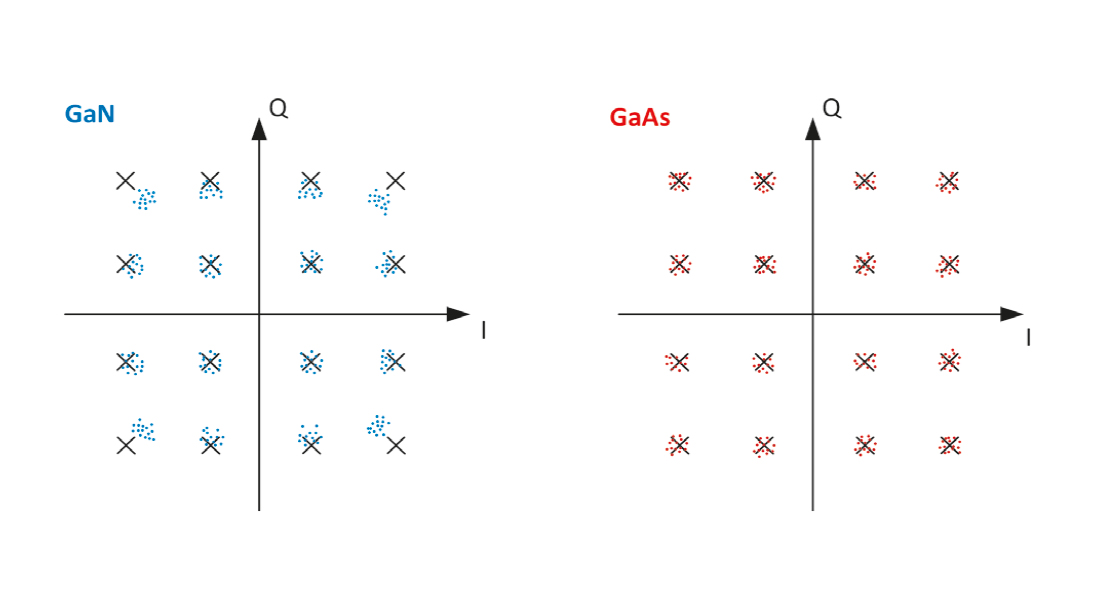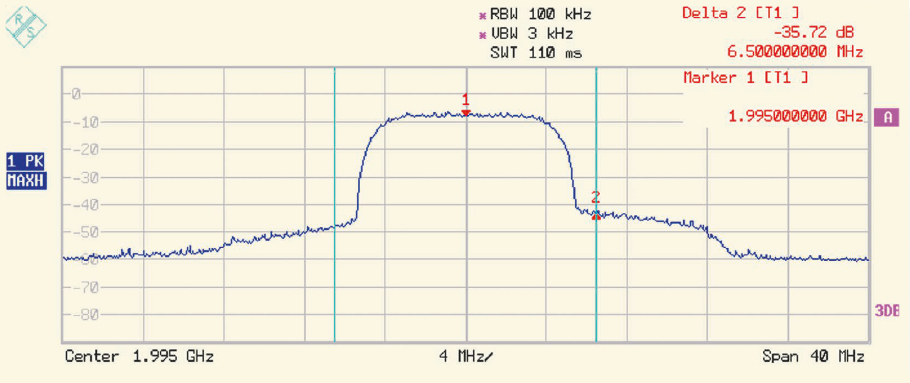Linearised amplifiers for OFDM-modulated signals and the challenges posed by Gallium Nitride Semiconductors

- Published date
-
November 29, 2024
The author of the text is Dr.-Ing. Sebastian Preis, from Alaris Kuhne.
Live broadcasts of sporting events, streaming events to larger user groups, venue casting, and data connections to commercial aircraft to enable in-flight connectivity—all these high-data-rate applications require highly linear power amplifiers in the transmitter. This ensures that the transmitted data is delivered to the respective receiver with minimal distortion.
The complex multi-carrier OFDM modulations used in DVB-T2, LTE, and 5G demand transmit amplifiers that introduce as little vector error as possible within the signal bandwidth. This parameter is expressed as EVM (Error Vector Magnitude). Additionally, it is essential to avoid interfering with adjacent channels, a factor quantified as ACLR (Adjacent Channel Leakage Ratio).
Linear Amplifiers
Kuhne offers a wide range of highly linear amplifiers for the C-band, such as the KU PA 440500 – 25 A, KU PA 510590 – 10 A, and KU PA 640729 – 10 A. Additionally, for the S-band, amplifiers with unparalleled linearity are available through the use of RF pre-distortion circuits, such as the KU PA 200240 – 80 LIN (Figure 1). The functionality of analogue RF linearisation will be discussed in more detail below.
Gallium Nitride Power Amplifiers
With the increasing demand for efficiency, gallium nitride (GaN) has emerged in recent years as the semiconductor material of choice for power amplifiers operating at high frequencies above 3 GHz. Compared to the previously dominant gallium arsenide (GaAs), GaN achieves not only a higher power density but also a significantly better efficiency, reaching over 70% (compared to around 20%) and significantly greater robustness against voltage stress and reflected power. This is made possible by the higher breakdown voltage of the material system. However, these advantages come at the cost of reduced linearity.
The commonly used GaN HEMTs (High Electron Mobility Transistors) exhibit amplitude compression at much lower input levels compared to GaAs (Figure 2), which leads to a pronounced reduction in gain between small-signal operation and saturation power. For modulated signals, this results in degraded EVM (Error Vector Magnitude) and signal quality, along with a reduced adjacent channel leakage ratio. The data points in the constellation diagram shift toward the centre and deviate particularly from the target values for outermost combinations (Figure 3). For regulatory reasons and to ensure the quality of the transmitted data stream, such compression is unacceptable.
Linearisation of Distorted Signals
Various approaches exist to correct distorted signals. One of the earliest methods involves pre-distortion of the nonlinear transistor characteristic using the nonlinear characteristic of another semiconductor. This is the classic case of a pre-distorter using diodes (Figure 4). Such solutions have been employed for decades to linearise both semiconductor amplifiers and vacuum tubes.
The more accurately the characteristic curve of a nonlinear component is known, and the less its nonlinearity varies with parameters such as signal bandwidth, drive level, temperature, or supply voltage, the easier it becomes to use diodes to compensate for the characteristic curve of the component in use.
However, the drawback is that a linearisation circuit based on diodes is relatively inflexible. Once the diode circuit is set up, it must be tailored to the specific amplifier and signal characteristics at a defined operating point, compensating only for that particular distortion. If a change in drive level or signal bandwidth alters the distortion, at a minimum, the operating point of the pre-distorter must be adjusted, or in the worst case, the entire circuit would need modification.
Digital Pre-Distortion (DPD)
Leading base station manufacturers like Nokia and Ericsson employ Digital Pre-Distortion (DPD) to mitigate distortions in power amplifiers. The concept is similar to diode-based pre-distortion, where the input signal is modified to counteract the amplifier’s nonlinear characteristics, resulting in a highly linear output signal. Unlike rigid diode circuits, DPD uses an FPGA to calculate the distortion caused by the amplifier for the current signal. This allows dynamic adjustments to various signal characteristics and operating ranges. The FPGA generates correction data, which is combined with the input data stream to produce a pre-distorted signal.
An example of a prominent DPD solution provider is Analog Devices. A key limitation of DPD is that it operates primarily at the baseband signal level, making it suitable only for systems with direct access to the baseband signal. Additionally, significant computational resources are needed to correct amplifier distortions in near real-time.
Radio Frequency Power Amplifier Linearizer (RFPAL)
The RFPAL concept, originally developed by Scintera, enables adaptive correction for varying signal characteristics and drive levels, much like DPD. However, RFPAL processes the analogue RF input signal directly, making it ideal for compact, linear amplifier systems without requiring access to the baseband or extensive computational power.
The RFPAL system features an adaptive analogue RF pre-distortion correction circuit that samples the RF signal at the amplifier output and input (via directional couplers) in the analogue domain. It then internally adjusts coefficients representing a Volterra series expansion of the waveform.
Volterra Series
A Volterra series models nonlinear behaviour, similar to a Taylor series but with the added ability to account for memory effects, making it better suited for amplifiers. This representation of the signal is processed digitally within the RFPAL chip to determine the necessary analogue coefficients for compensating amplifier nonlinearity. The system then generates an RF correction signal, which is fed back into the RF path at the amplifier input via another directional coupler.
Because RFPAL operates entirely in the analogue domain, it consumes significantly less power (typically under 1 watt) compared to digital pre-distortion solutions. However, current RFPAL chips have a maximum operating frequency of 3800 MHz, limiting their use in higher frequency applications.
Linearising GaN Amplifiers Above 4 GHz
A typical frequency range for transmitting video data streams during sports events lies between 4400 and 5000 MHz. As mentioned earlier, this has long been a classic application area for GaAs semiconductors, which are now poorly available. Alternatives based on LDMOS (Laterally Diffused Metal-Oxide Semiconductor) are no longer usable here due to their high input and output capacitances at such frequencies. The semiconductor market is now shifting towards GaN (Gallium Nitride) devices, which, for complex modulations in video data streams, again demand linearization.
The limitations of the linearization approaches described in the previous section require careful system design in this context. As different signals, drive levels, and the lack of access to the baseband signal dominate, the obvious solution is to use an RFPAL. Image 5 shows the schematic layout of the circuit.
Implementation with the RFPAL
Since the RFPAL's maximum operating frequency is below the required frequency range, the actual RF signal is downconverted to an intermediate frequency (IF) range in which the RFPAL can operate. For the actual power amplification, the IF signal is then upconverted again. In the final stage, the signal experiences distortion. Before the output, the RF signal is extracted, fed back to the mixer block, and converted back into the IF range. In this way, the RFPAL always has access to both the input signal and the distorted output signal. It calculates the correction signal, which is then injected into the IF path before the upconverter.
For any change in the signal—whether it’s bandwidth, crest factor, or average drive level—the system can flexibly respond to the altered distortion of the final stage transistor.
Improvement in Adjacent Channel Leakage Ratio (ACLR)
Measurements of an LDMOS-based final stage (KU PA 200240 – 80 LIN) with the RFPAL in front show an improvement in the adjacent channel leakage ratio from 35 dB (Image 6) to 50 dB (Image 7). On the other hand, targeting an Error Vector Magnitude (EVM) of, for example, 2%, the use of the RFPAL can double to triple the average output power for a signal.
Improved Efficiency
In addition to the excellent linearity shown, a GaN-based power amplifier achieves an efficiency improvement of up to 25% in the context of a modulated video signal at approximately 5 W average power, compared to 5% in GaAs-based amplifiers. For example, the KU PA 440500 – 40 LIN, with the excellent linearity characteristics of the well-known linearized Kuhne amplifiers, is capable of providing at least 5 W of average power for an OFDM-modulated signal. The high power density and efficiency of GaN transistors allow to keep the KU PA 200240 – 80 LIN form factor.
Feedback Path
Fundamentally, the concept of frequency translation and linearization at the IF (intermediate frequency) level can be applied to almost any frequency band. However, it should be noted that any nonlinearities that occur outside the feedback path between the final stage and the RFPAL cannot be corrected. For example, if the first downconverter (mixer) in Image 5 already generates distortions, the RFPAL cannot remove these from the output signal of the final stage, as the distorted signal components are already present in the decoupled comparison signal at the input.
Advantages for System Integration
A linearized amplifier based on GaN HEMTs, with the help of the RFPAL, achieves comparable, if not better, linearity than GaAs-based amplifiers. At the same time, their power consumption is significantly reduced, which in turn significantly lowers the cooling requirements of the system. Due to the high power density of GaN, one can also consider a possible higher package density of transistors, which allows for an increase in amplifier power while maintaining the same form factor. All these advantages enable more powerful amplifier systems for point-to-point connections in video live broadcasts, high data rate links for (airborne) vehicles, venue casting, or other applications that require high signal quality and output power with high efficiency.
Outlook for the Future
Looking ahead, the average efficiency for modulated signals can be further increased by using efficient amplifier architectures, such as the Doherty configuration. In traditional amplifiers, the maximum efficiency and maximum output power almost align with the same input power value. However, since the signal amplitude of OFDM-modulated signals has a probability distribution around the signal's average power, the peak efficiency is typically not very useful for real-world operation. The probability distribution is shown in the background as a grey area in Image 8.
Doherty Architecture
The difference between average power and peak power in the signal is known as PAPR (Peak-to-Average Power Ratio) or crest factor. The higher this value, the more powerful an amplifier must be designed to deliver a given average power. A Doherty amplifier contains at least two transistors working in parallel (main and auxiliary transistors), which are activated at different input levels and thus reach their peak power and efficiency at different times. This results in a region of high efficiency, typically starting at least 6 dB below the amplifier's saturation power. Depending on the design of the Doherty stage, this high-efficiency region can extend further into the back-off range, thus allowing for more efficient amplication of signals with high PAPR.
RFPAL for Doherty
Since the RFPAL can correct both amplitude and phase errors, it is also feasible to linearize Doherty amplifiers. By distributing the efficiency maxima of the different individual transistors, as shown in Image 8, the overall system's average efficiency can be increased to get closer towards the peak efficiency dominated by the semiconductor. Thus, by using RFPAL components, highly efficient amplifiers can be operated in a highly linear manner simultaneously.
Outstanding Amplifiers for Modulated Applications
For years, Kuhne has been producing linearized amplifiers for frequency bands in the S- and L-band using RFPAL components. Prototypes of new C-band systems are currently being developed, and Doherty designs are available for applications with extended efficiency requirements. Linearity, efficiency, and power are a trio that was long difficult to combine. With the latest components, this challenge can be overcome, and outstanding amplifiers for modulated applications are becoming a reality.
Download original article as featured in HF-Praxis
Other articles








Alaris Group Shines at DSEI 2023
September 12, 2023
The Alaris Group was thrilled to attend the highly anticipated DSEI 2023, with full representation from across our global subsidiaries: Alaris Antenna...


Optimizing Precision Systems with Ring-Focused Feeds for Antenna Systems
February 6, 2025
oday’s complex landscape of satellite communication, radar applications, and scientific research projects demand high-performance antennas. The need h...


ISO9001 quality management system external audit
June 1, 2022
Kuhne recently completed their annual ISO 9001 Quality Management System external audit with resounding success.



Alaris COJOT & Alaris Kuhne attend RÜ.NET 2024
September 4, 2024
RÜ.NET is a trade fair and conference for armament and utilisation in Germany that takes place annually. The 2024 event was held on September 4–5 at t...
Stay Connected with Alaris
Join our newsletter to receive the latest insights, product updates, and innovations in radio frequency (RF) technology directly in your inbox. Stay ahead with industry-leading solutions from Alaris.
- Industry Insights
- Receive exclusive insights into cutting-edge RF technologies, market trends, and innovations shaping the future of connectivity.
- No clutter, just value
- We respect your inbox. Expect no spam, only valuable and relevant updates.









